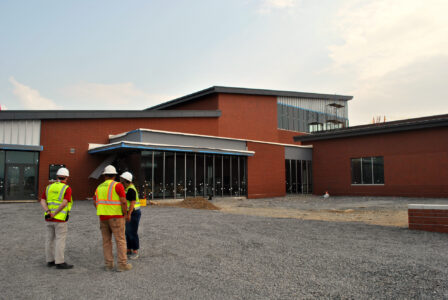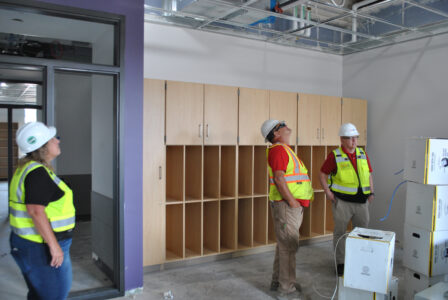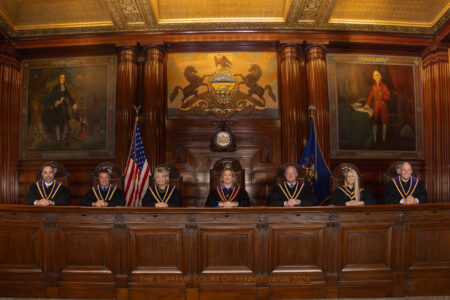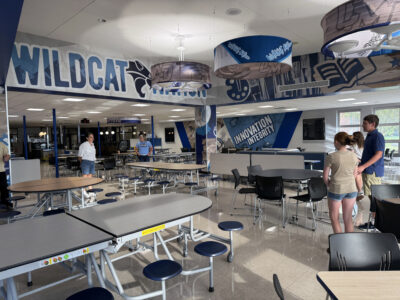Bellefonte Elementary construction project on track for fall 2026
- HUNTER SMITH/THE EXPRESS From left, Superintendent Roy Rakszawski, School Board President Jon Guizar and SitelogIQ consultant Tammie Burnaford are pictured in front of the construction site.
- HUNTER SMITH/THE EXPRESS Pictured are the Learning Stairs, still under construction at the new Bellefonte Elementary.
- HUNTER SMITH/THE EXPRESS Classrooms at the new building will be color coordinated to assist children in finding their way about.
- HUNTER SMITH/THE EXPRESS From left, SitelogIQ consultant Tammie Burnaford, School Board President Jon Guizar and Superintendent Roy Rakszawski are pictured while examining some of the handiwork at the job site.

HUNTER SMITH/THE EXPRESS From left, Superintendent Roy Rakszawski, School Board President Jon Guizar and SitelogIQ consultant Tammie Burnaford are pictured in front of the construction site.
BELLEFONTE — A year into construction and a year away from welcoming students, Bellefonte’s new state-of-the-art elementary school is taking shape exactly as administrators envisioned.
The $55 million project along Airport Road is quickly nearing completion and remains on schedule and within budget. The 98,000-square-foot facility is expected to be substantially completed by December, with doors opening to students in fall 2026.
When it does, the building will accommodate about 600 students between grades K-5, with room to expand in the future.
The Express toured the building with representatives from the district and construction management firm, SitelogIQ, to see the progress firsthand.
KEY FEATURES AND DESIGN CONSIDERATIONS

HUNTER SMITH/THE EXPRESS Pictured are the Learning Stairs, still under construction at the new Bellefonte Elementary.
When designing the school, “We tried to think of every possible thing,” said School Board President Jon Guizar.
According to administrators, the school was engineered with the community in mind, blending modern features with flexible, customized learning spaces.
“It was really designed around what the community wanted as far as size of school and then optimized for cost per student per square foot,” Guizar said.
Although construction began only in June 2024, the project was years in the making.
“Before we started the two years of planning for this building, we spent another two or three years doing community listening meetings where we went to each of the individual elementary schools and invited the community in to ask, ‘What’s important to you for your kids,'” he said

HUNTER SMITH/THE EXPRESS Classrooms at the new building will be color coordinated to assist children in finding their way about.
That feedback shaped the work of architect KCBA, which developed a design that would support high-quality education while remaining cost- and energy-efficient.
Security
When planning the new elementary, administrators made safety their top priority.
“There’s a ton of safety features in this building,” said former superintendent Tammie Burnaford, who now serves as a consultant for SitelogIQ.
While not all features have been disclosed for security reasons, the district said families can feel confident those protections are in place.
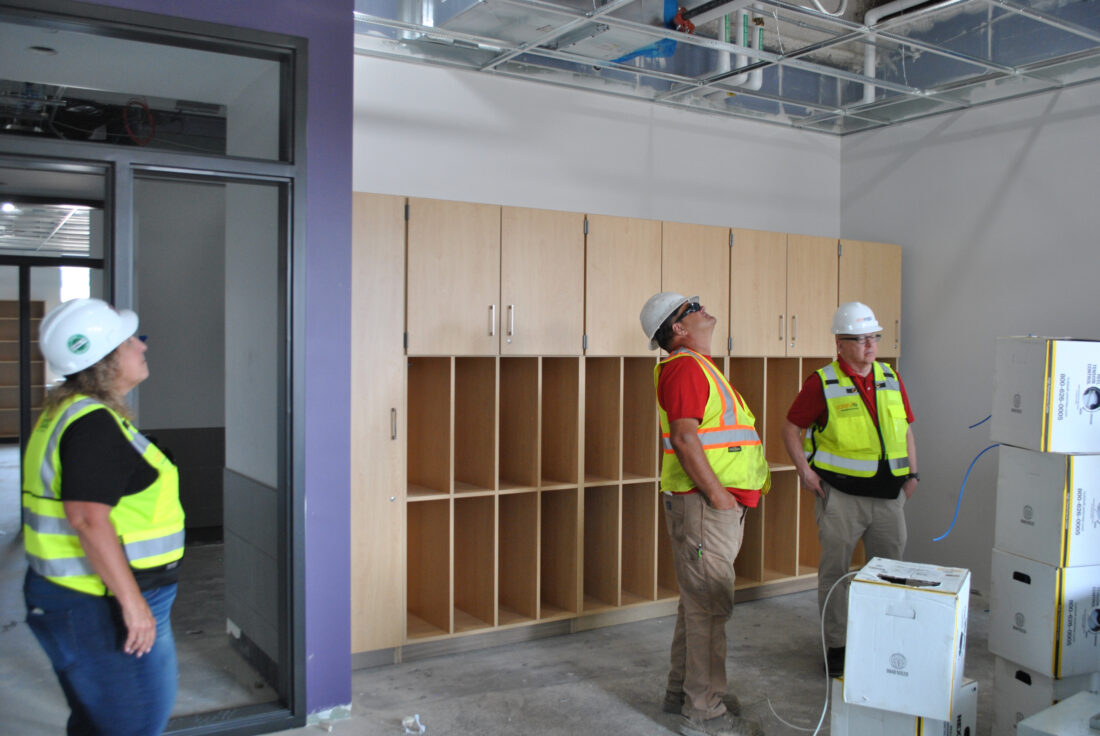
HUNTER SMITH/THE EXPRESS From left, SitelogIQ consultant Tammie Burnaford, School Board President Jon Guizar and Superintendent Roy Rakszawski are pictured while examining some of the handiwork at the job site.
Among the more visible features are secure entry vestibules, glazed glass windows that limit outside views and hallways designed with intentional bends to prevent long sightlines in the event of an intruder.
Outside, parking lots reflect the same careful planning, with traffic patterns created to avoid congestion and reduce accident risks.
Some of those safety features also carry added benefits.
“The way that the halls are offset also enhances the small school feel,” said school board president Jon Guizar. Likewise, separating parent and bus traffic is expected to make pick-ups and drop-offs both smoother and safer.
Flexibility
Designed to accommodate changes in teaching methods and student demographics over its lifetime, the school was built with flexibility in mind.
“This is a school for the next 50 years,” said Burnaford. So when designing the building, she said it was important to ask, “How do you make the space adaptable should you need to adapt it?”
For BASD, the solution was a modular classroom design, with stub outs at the ends of the halls where additional classrooms can be added as the district grows. For the same reason, all classroom pods are flexible, allowing the number of classrooms per grade level to be adjusted based on enrollment.
Adaptability extends beyond the classrooms; Multi-use spaces are woven throughout the building, with hallways that feature small-group instruction areas where students can receive personalized support. Other spaces, including the gymnasium, courtyard and Learning Stairs, were also designed with flexibility in mind to ensure they serve the district’s needs for at least the next five decades.
The gymnasium, for example, was built to regulation width but shortened in length to make room for a stage — a compromise that allows for both athletic use and performances.
“You could hold high school practices in here, and you could play everything but varsity basketball,” Burnaford said.
Likewise, the building’s sizable courtyard can be used for outdoor education, including science lessons, physical activity and even musical performances. The “Learning Stairs,” a tiered space where multiple classes can gather simultaneously for presentations, group activities or lessons, is similarly versatile.
Customization
Community and staff input guided many aspects of the design.
The faculty emphasized the need for multi-use spaces, and that feedback is reflected throughout the building. Teachers also asked for more storage, some of which was being installed during the tour.
Special subject areas were also designed with intention. The art studio includes a kiln and generous supply space, while music rooms feature on-site instrument storage. Together, these features equip instructors to better meet student needs.
To further support the learning environment, the administration incorporated sound-dampening materials in the cafeteria and music rooms.
Accessibility
Customization was also applied throughout the school to ensure it is accessible and supportive of students in special education.
“We tried to design rooms that would be conducive to the type of learner they had,” said Burnaford.
For example, life skills classrooms will be equipped with hoists and other mechanical features, including widened doorways to more easily accommodate wheelchairs and a full-size restroom for changing needs.
Similarly, the school’s emotional support classrooms will feature sensory rooms where students can go to decompress when overstimulated by the classroom environment.
These classrooms also provide easy access to the adaptive playground, which includes specialized equipment so all children can participate in recess.
When reviewing the design, Guizar said he told the construction team, “If you put yourself in a wheelchair, I want you to be able to go to every space in this building. There should be nothing that’s off-limits to someone in a wheelchair.”
In addition to physical accessibility, the school also considered wayfinding for young learners and visitors. Because many students are just beginning to read, the halls are designed using a system of colors and shapes to help children and those unfamiliar with the school navigate. Each classroom incorporates its respective coordinated color-and-shape combination to reinforce the system.
Efficiency
Because the school represents a significant investment for the district, and by extension the community, “We sought to minimize the lifecycle cost of the building in every discipline,” said Guizar.
The district implemented several strategies to reduce long-term costs. One approach was using high-quality materials rather than cutting corners. For example, for flooring, the board chose terrazzo and luxury vinyl tiles.
“It was more expensive, but they will last for 50 years, and they don’t have to be waxed or stripped, which saves custodial time,” said Burnaford.
The same philosophy guided the building’s mechanical systems. For example, rather than relying on a single large water heater, the school uses multiple smaller units and keeps spare parts on hand. That way, if one system fails, others can continue running or be quickly repaired, reducing disruption.
The building’s design also allows for hot water to circulate throughout the entire building, making it instantly accessible even at the farthest reaches of the school.
Heating and cooling are controlled individually in each classroom rather than by a single central system, which not only improves energy efficiency but also helps minimize noise.
Character
From the moment visitors approach, Bellefonte’s new elementary school is designed to tell a story. The front of the building is anchored by special subject classrooms, led by the library.
“The first thing you see when you come up the hill is the library, because symbolically we wanted reading to be our focus,” said Burnaford.
That prominence was intentional. Burnaford explained that the front half of the school was arranged around spaces the district wanted the community to use and enjoy.
“This is the community’s building,” said Guizar. “Because it is being paid for by the community, we want to leave it open as much as possible, while still separating classroom spaces for obvious reasons.”
The elementary’s community-facing spaces include the library, gymnasium, offices, restrooms, extracurricular classrooms and cafeteria, which will also host the district’s daycare program. Each space is high-tech and carefully designed to reflect Bellefonte Elementary’s mission.
There, students will have access to a TV studio for broadcasting morning announcements, as well as a STEM lab that doubles as a makerspace, giving them room to explore, experiment and create.
Connecting these spaces is the “Hallway of History,” a central artery designed to celebrate Bellefonte’s heritage.
“Bellefonte has an extremely rich history, and so this is called the Hall of History,” Burnaford said. “This hallway will feature pictures and displays highlighting the history of Bellefonte.” Though the theme is still under wraps, the hallway will honor both Bellefonte and Benner elementaries, celebrating the legacies of students and alumni as those schools close.
The school also weaves the town’s heritage into its design in more subtle ways.
Architect Mike Kelly of KCBA added decorative brows above the windows as a nod to Bellefonte’s historic architecture, and the brick and mortar evoke the style of Anna Keichline, Pennsylvania’s first female professional architect and a native of the town.
Outstanding projects
While the building is on track for substantial completion by year’s end, several key tasks remain. The district is still finalizing the design for the main playground, which was not included in the initial plans, and furniture orders are pending as quotes continue to come in.
Another major decision will involve redrawing elementary school boundaries. Superintendent Dr. Roy Rakszawski said the district will wait to see the size of the incoming kindergarten class before making changes.
“We’ve done a lot of planning for various scenarios,” Rakszawski said. “I would anticipate any announcements to any potential boundary changes to happen in November.”
Leadership at the new school has also been set. When the new Bellefonte Elementary opens, the existing Bellefonte Elementary and Benner Elementary will close. Their principals, Michael Baughman and Dan Park, will serve as co-principals, overseeing grades K-2 and 3-5 respectively.
“We’ve thought a lot about how all of this will work,” said Rakszawski, “But there is still more to do.”
Takeways
At the end of the tour, Guizar, Burnaford and Rakszawski reflected on lessons they hope future boards will carry forward–chief among them, listening to the community and being willing to take the leap.
“You can never build it cheaper than you can today,” said Guizar.
In Bellefonte, a new elementary school had been delayed for decades. Guizar described the district as stuck in “analysis paralysis,” but ultimately, he said, the board recognized the need to act. “I think school boards tend to find ways to keep the cost down. You cannot skimp on design and inspection,” he added. “You need a construction manager.”
Burnaford also emphasized that cutting corners is not always cost-effective. Investments such as soundproof tiling and luxury vinyl floors, she said, can make the difference between a durable, high-quality building and one that falls short of supporting student learning.
Burnaford, whose longtime dream as superintendent was to see a new elementary school built, said she is eager for move-in day.
“I can’t even imagine how the kids who have been in a building without air conditioning will react to this new school,” she said.

